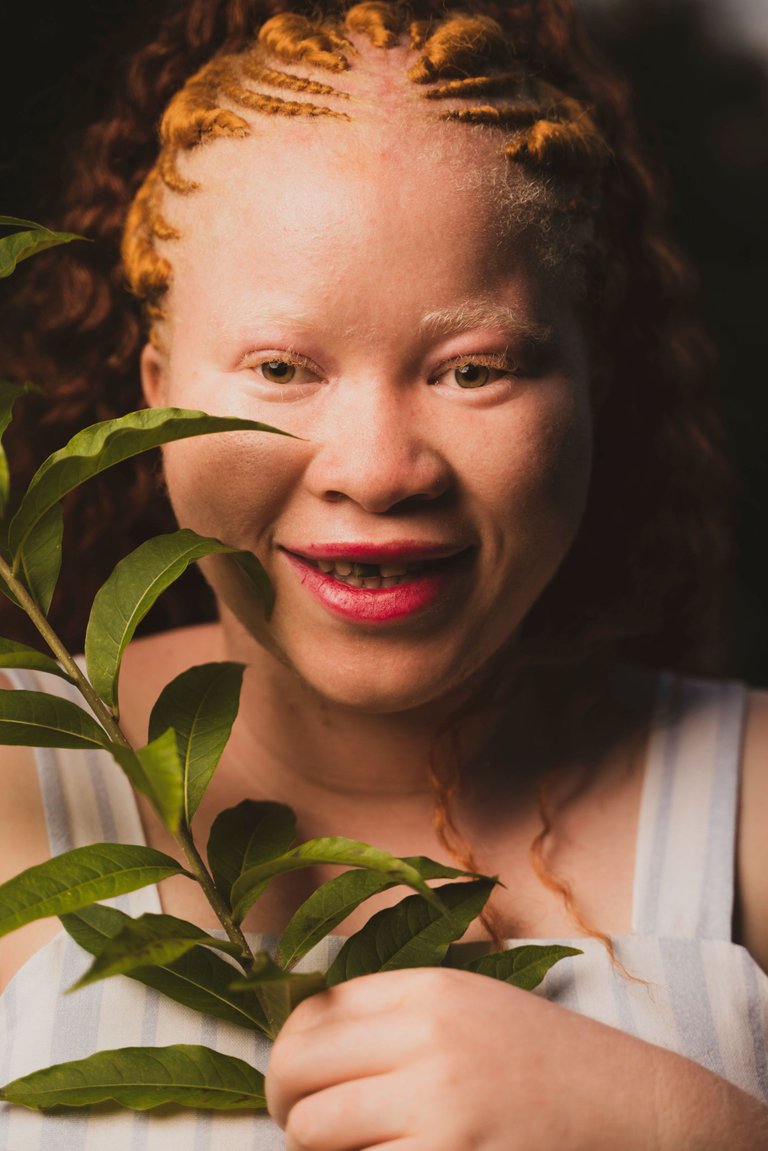What you did not know about Albinism.
Introduction
Albinism alludes to a scope of problems that outcome from a decrease in or absence of the pigment melanin. These vary in seriousness, yet they frequently cause white skin, light hair, and vision issues.
Albinism can influence anybody, however its pervasiveness changes by the region.
In sub-Saharan Africa, albinism influences 1 in each 2,000 to 5,000 individuals. Among certain groups, the rate is basically as high as 1 out of 1,000. In Europe and the United States, it is more like 1 of every 17,000 to 20,000.
Albinism influences the genders uniformly, and all ethnic groups are susceptible.
The following are a few central issues about albinism.
• Albinism is a hereditary condition.
• It fundamentally influences the hair, eyes, skin, and vision.
• There is no cure for albinism, however, a few side effects are treatable.
• An expected 1 of every 70 individuals carry the genetic mutation associated with albinism.
What is albinism?
Albinism is an acquired disease characterized by a considerably low rate of melanin production.
Melanin is the pigment responsible for the shade of the skin, hair, and eyes.
Individuals with albinism frequently have lighter shaded skin and hair than other individuals from their family or ethnic group. Vision issues are likewise expected.
Melanin regularly shields the skin from harm because of UV radiation exposure, so individuals with albinism are more sensitive to sun exposure. They likewise have an increased risk of developing skin cancer even as early as the young adult years.
Types
Albinism has two fundamental sorts: ocular albinism (OA), which basically affects the eyes, and oculocutaneous albinism (OCA), which affects the skin, hair, and eyes.
Specialists further partition OCA into various subgroups depending on the particular qualities it influences.
These subdivisions include:
• OCA type 1: Individuals will more often than not have smooth skin, white hair, and blue eyes. With age, a few people's skin and hair might be obscure.
• OCA type 2: Less serious than type 1, this happens most frequently in sub-Saharan Africans, African Americans, and a few Native American people groups.
• OCA type 3: Vision issues are typically milder in type 3 than in different kinds. This type for the most part influences Black South Africans.
• OCA type 4: This type is generally normal among East Asian populaces. It presents in basically the same manner to type 2.
• X-connected visual albinism: A hereditary change in the X chromosome causes X-connected visual albinism, which for the most part influences guys. Vision issues are available, however, eye, hair, and skin tone are by and large inside the ordinary reach.
• Hermansky-Pudlak condition: This uncommon variation is most seen in Puerto Rico. The side effects are like those of oculocutaneous albinism, however, gut, heart, kidney, and lung illnesses or bleeding issues, like hemophilia, are more probable.
• Chediak-Higashi condition: This is an extremely uncommon type of albinism coming about because of a transformation in the CHS1 quality. The side effects might look like those of oculocutaneous albinism, however, an individual's hair can seem brilliant, and their skin can look marginally dark. They may have defective white blood cells, making the individual more susceptible to diseases.
Symptoms
The fundamental side effects of albinism influence the vision and the shade of the skin, hair, and eyes.
Skin
The clearest indication of albinism is a lighter complexion, albeit this isn't generally the situation. In certain individuals, levels of melanin gradually increment over the long run, obscuring the complexion as the individual ages.
A singular's skin might consume effectively in the sun, and it doesn't normally tan. After sun exposure, certain individuals with albinism could develop:
• freckles
• moles, which are generally pink in variety because of the decreased amounts of color
• lentigines, which are enormous freckle-like spots
There is likewise a higher gamble of skin malignant growth. Individuals with albinism ought to utilize sunscreen with an SPF of something like 20 and report any new moles or other skin changes to a specialist.
Hair
In individuals with albinism, hair tone can go from white to brown. Those of African or Asian plummet will generally have yellow, brown, or rosy hair.
As the singular ages, their hair tone may gradually obscure.
Eye tone
Eye tone may likewise change with age and can shift from extremely light blue to brown.
Low degrees of melanin in the iris imply that the eyes can show up somewhat clear and, in a specific light, look red or pink as the light gleams off the retina at the rear of the eye.
The absence of color keeps the iris from completely hindering daylight, so the individual is delicate to light. Specialists call this photosensitivity.
Vision
A wide range of albinism influences the vision somewhat. Potential changes to eye capability include:
• Nystagmus: The eyes move quickly and wildly this way and that.
• Strabismus: The eyes don't adjust.
• Amblyopia: This is the clinical name for a languid eye.
• Nearsightedness or hypermetropia: The individual might have outrageous partial blindness or farsightedness.
• Photophobia: The eyes are especially delicate to light.
• Optic nerve hypoplasia: Visual impairment happens in light of the fact that a singular optic nerve is undeveloped.
• Optic nerve misrouting: Nerve signals from the retina to the mind follow uncommon nerve courses.
• Astigmatism: An unusual rigidity of the front surface of the eye or focal point brings about obscured vision.
Techniques that might help include:
• joining exceptional adaptive focal points to glasses
• utilizing an enormous PC screen or high difference print material
• introducing programming that switches text over completely to discourse
• utilizing a brilliantly shaded ball while messing around
Causes
Specific cells in the skin, hair, and eyes called melanocytes produce melanin. In the event that there is an adjustment of one of these qualities, it can cause albinism. Specialists gauge that 1 of every 70 individuals conveys these qualities.
Most usually, the changes impede a compound called tyrosinase. This protein separates the amino corrosive tyrosine and makes melanin.
Contingent upon the particular change, melanin creation either dials back or stops altogether.
As melanin assumes an essential part in retinal and optic nerve development, these hereditary changes cause visual issues.
Is it hereditary?
Yes indeed, albinism is hereditary. Most sorts of albinism have what specialists call an autosomal recessive inheritance pattern. The special case is X-linked ocular albinism, which has an X-linked inheritance pattern.
Autosomal recessive inheritance pattern
With autosomal latent legacy, an individual should get changed duplicates of quality from both the mother and father to foster albinism. The parent who conveys the quality frequently doesn't show side effects.
Assuming the two parents carry the trait but have no symptoms, there is a 1 out of 4 chance that the youngster will have albinism.
There is a 1 out of 2 chance that the youngster will turn into a carrier, implying that they carry the gene but have no symptoms.
X-linked inheritance pattern.
X-connected passive circumstances mostly influence guys. The justification behind this is that females carry two X chromosomes, so assuming one gene is mutated, the other can frequently make up the deficit. Be that as it may, females can in any case carry and pass on the affected gene.
Males, be that as it may, have one X and one Y chromosome. Accordingly, any pale-skinned person with changes in their singular X chromosome will produce the condition.
In the event that the mother has an X-linked mutation, every girl has a 1 out of 2 chance of turning into a carrier, and each son has a 1 out of 2 chance of developing albinism.
Diagnosis
The most common way of diagnosing albinism might include:
• a physical examination
• a conversation about skin and hair pigmentation changes
• the assessment of the eyes by an ophthalmologist, an expert eye specialist
• a correlation of the singular's hue with that of natural relatives
Different sicknesses can likewise cause changes in pigmentation, yet they don't cause vision changes. In the event that color and vision changes are both present, specialists look at albinism as a probable conclusion.
Hereditary testing is the most solid method for diagnosing albinism. Nonetheless, it is costly, and specialists don't think of it as important in families with a background marked by albinism.
Treatment
Albinism is a lifelong hereditary condition with no cure. Thusly, treatment centers around limiting the symptoms and looking out for skin changes.
Individuals with albinism should get proper eye care, including:
• prescription glasses
• dark glasses to safeguard the eyes from the sun
• regular eye tests
A surgical procedure on the optical muscles can some of the time, limit the "shaking" that happens in nystagmus. Procedures to limit strabismus can make it less perceptible, however, surgery doesn't improve the vision.
The degree of progress in decreasing symptoms changes among people.
Individuals ought to watch their skin cautiously for any progressions and use sunscreen for protection.
Complications
The most widely recognized actual issues related to albinism are burns from the sun and skin cancers.
Visual deficiencies can likewise restrict a person's career potential opportunities and their capacity to drive. Moreover, an individual might have reading difficulties that may lead to academic deferrals.
Individuals might confront huge social issues, for example, social separation and disgrace at school or in the work environment since they appear to be different.
These social variables can prompt pressure, low confidence, insecurity, and detachment. People with albinism in sub-Saharan Africa might confront the main hardships.
In a few African nations, certain individuals believe that having intercourse with a lady with albinism cures AIDS. This deception has prompted murder, assault, and extra HIV contaminations.
In 2015, the United Nations called for "urgency" in going to lengths to stop the assaults on individuals with albinism.
Conclusion
Individuals with albinism have changes in the qualities that produce melanin. As melanin is liable for giving tone to the skin, hair, and eyes, individuals with albinism need pigmentation.
Albinism is a hereditary condition that goes down through families. There are different kinds of albinism with varying degrees of symptom seriousness, contingent upon the impacted qualities.
Individuals with albinism have changes to their vision since melanin influences solid eye development. They are likewise more inclined to burn in the sun and develop skin cancer.
There is no cure, however the management centers around safeguarding the skin and eyes from the sun and looking for any changes in the skin.
References
• 2021 theme — strength beyond all odds. (n.d.).
https://www.un.org/en/observances/albinism-day
• Albinism. (2016).
https://rarediseases.info.nih.gov/diseases/5768/albinism
• Albinism. (2020).
https://www.nhs.uk/conditions/albinism/
• Urgent appeal by UN rights expert to stop ‘abhorrent’ attacks against persons with albinism. (2015).
https://news.un.org/en/story/2015/10/512682-urgent-appeal-un-rights-expert-stop-abhorrent-attacks-against-persons-albinism
• What is albinism? (2020).
https://aapos.org/glossary/albinism




Congratulations @topdollar001! You have completed the following achievement on the Hive blockchain and have been rewarded with new badge(s):
Your next target is to reach 4000 upvotes.
You can view your badges on your board and compare yourself to others in the Ranking
If you no longer want to receive notifications, reply to this comment with the word
STOPCheck out the last post from @hivebuzz:
Support the HiveBuzz project. Vote for our proposal!